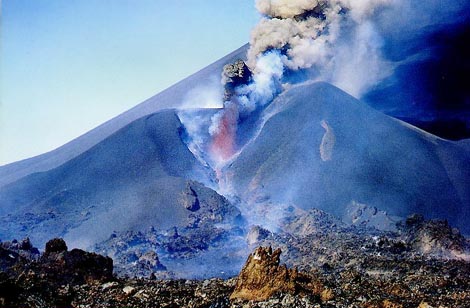 Paulo Alves and Guilherme Madureira, technicians from the Geophysics Division of the Portuguese Institute of the Sea and Atmosphere (IPMA), support the operation of the seismological network of Ilha do Fogo, as part of the Science and Technology Foundation (C4G) team and in collaboration with the National Institute of Meteorology and Geophysics of Cape Verde.
Paulo Alves and Guilherme Madureira, technicians from the Geophysics Division of the Portuguese Institute of the Sea and Atmosphere (IPMA), support the operation of the seismological network of Ilha do Fogo, as part of the Science and Technology Foundation (C4G) team and in collaboration with the National Institute of Meteorology and Geophysics of Cape Verde.
Five broadband stations from the Institute have already been sent to reinforce the capacity for seismological observation. Another five stations were also made available by the University of Évora.
On November 23, at 10:00 am local time, an eruption began at the Fogo volcano, located in Cape Verde, on the island with the same name. The eruption was preceded by intense seismic activity, with several earthquakes being felt by the local population.
There has already been serious damage to that island, with some houses and roads having been affected by the advance of the lava flows. The population of Chã das Caldeiras has already been evacuated. There are also problems with communications.
This Sunday, volcanic activity intensified again and the large amount of expelled lava, which reached a speed of one meter per second, destroyed part of the headquarters of the Natural Park and threatens to bury the town of Portela, having already destroyed houses, agricultural annexes, corrals, cisterns and cultivated fields.
It is possible to monitor the emissions of Sulfur Dioxide (SO2) by the active volcano through images from the EUMETSAT Meteosat 10 satellite.
As animation images at 15-minute intervals between 03:15 and 15:00 (Lisbon time) on 24 November, they result from the combination of different channels in the infrared region of the electromagnetic spectrum and allow the identification of SO2 in shades of green-water.
These images, according to IPMA, also suggested the non-existence of volcanic ash in the atmosphere at that time, as well as allowing for the identification of warmer regions on the surface associated with volcanic lava.
The last eruption of this volcano occurred in April 1995, at the same location as the current one. Almost 1500 eruptions have been known since 30, the last two of which occurred in the 1951th century, in 1995 and XNUMX.


















Comments